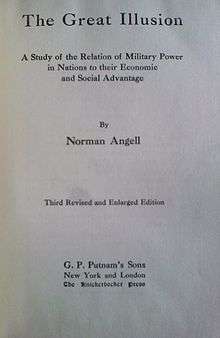The Great Illusion
 | |
| Authors | Norman Angell |
|---|---|
| Original title | Europe's Optical Illusion |
| Language | English |
Publication date | 1909; 1933 |
The Great Illusion is a book by Norman Angell, first published in the United Kingdom in 1909 under the title Europe's Optical Illusion[1] and republished in 1910 and subsequently in various enlarged and revised editions under the title The Great Illusion.[2]
Content
Angell argued that war between industrial countries was futile because conquest did not pay. J.D.B. Miller writes: "The 'Great Illusion' was that nations gained by armed confrontation, militarism, war, or conquest."[3] The economic interdependence between industrial countries meant that war would be economically harmful to all the countries involved. Moreover, if a conquering power confiscated property in the territory it seized, "the incentive to produce [of the local population] would be sapped and the conquered area be rendered worthless. Thus, the conquering power had to leave property in the hands of the local population while incurring the costs of conquest and occupation."[3]
Angell said that arms build-up, for example the naval race that was happening as he wrote the book in the early 1910s, was not going to secure peace. Instead, it would lead to increased insecurity and thus increase the likelihood of war. Only respect for international law, a world court, in which issues would be dealt with logically and peaceably would be the route for peace.
A new edition of The Great Illusion was published in 1933; it added "the theme of collective defence."[4] Angell was awarded the Nobel Peace Prize in 1933. He added his belief that if France, Britain, Poland, Czechoslovakia, etc. had bound themselves together to oppose all military aggression, including that of Hitler's, and to appeal to world justice for solution to countries' grievances, then the great mass of reasonable Germans would have stepped up and stopped Hitler from leading their country into an unwinnable war, and World War II would have been avoided.
Critical reception
It is sometimes said that the outbreak of World War I disproved Angell's argument in The Great Illusion, but Angell had not maintained that a war was impossible, rather that it would be futile. Although some aspects of Angell's argument have dated, his discussion of economic interdependence "was important and innovative."[5]
In popular culture
The Great Illusion was mentioned in the novel Death of a Hero by Richard Aldington. It was used as evidence by the main character that the coming World War I would not happen.
One of the characters in the D. K. Broster story "The Window" (1929), set in pre-World War I France, mentions having read Angell's book, and uses it to argue that "it is impossible that there should be a great war nowadays".[6]
The Great Illusion is also mentioned early in Barbara Tuchman's The Guns of August as reflecting British attitudes on the eve of the first world war. Tuchman contrasts Britain's enthusiasm for the The Great Illusion, and its implicit guarantee against the outbreak of another war, with Germany's preference for Germany and the Next War by Friedrich von Bernhardi, which argued for war as inevitable and necessary.
See also
- Grand Illusion (1937), classic French film whose title was inspired by the book
References
- ↑ Angell, Norman (1909), Europe's Optical Illusion (1 ed.), London: Simpkin, Marshall, Hamilton, Kent & Co., retrieved 15 June 2016 – via Internet Archive
- ↑ Angell, Norman (1911), The Great Illusion: A Study of the Relation of Military Power in Nations to their Economic and Social Advantage (3 ed.), New York and London: G.P. Putnam's & Sons, retrieved 9 June 2016
- 1 2 Miller (1995), p.105.
- ↑ Miller (1985) p.120 n.9.
- ↑ Miller (1985), p.106.
- ↑ Andrew J. Williams, France, Britain and the United States in the twentieth century,1900-1940 : a reappraisal. Houndmills, Basingstoke, Hampshire : Palgrave Macmillan, 2014. ISBN 9780230282308 (p.48).
Further reading
- Miller, J. D. B. "Norman Angell and Rationality in International Relations", in D. Long and P. Wilson, eds., Thinkers of the Twenty Years' Crisis (1995)
- Miller, J. D. B. Norman Angell and the Futility of War (1986).
- Liberman, Peter. Does Conquest Pay? (1996).
